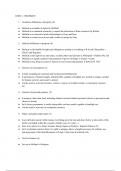Summary
Intro to Property Law Course Summary
- Module
- Property Law (LA24815)
- Institution
- The University Of Warwick (UoW)
Summary of my lecture notes and readings for every module in first year Intro to Property Law. Written in 'question-answer' format to help with memorising and covers all major issues, cases, etc. for the multiple choice exam. Helped me get 100% on the exam, so hopefully it helps you too!
[Show more]



